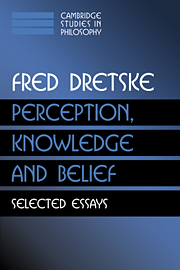Book contents
- Frontmatter
- Contents
- Preface
- Part One Knowledge
- Part Two Perception and Experience
- Part Three Thought and Intentionality
- 11 Putting Information to Work
- 12 If You Can't Make One, You Don't Know How It Works
- 13 The Nature of Thought
- 14 Norms, History, and the Constitution of the Mental
- 15 Minds, Machines, and Money: What Really Explains Behavior
- Index
12 - If You Can't Make One, You Don't Know How It Works
Published online by Cambridge University Press: 19 December 2009
- Frontmatter
- Contents
- Preface
- Part One Knowledge
- Part Two Perception and Experience
- Part Three Thought and Intentionality
- 11 Putting Information to Work
- 12 If You Can't Make One, You Don't Know How It Works
- 13 The Nature of Thought
- 14 Norms, History, and the Constitution of the Mental
- 15 Minds, Machines, and Money: What Really Explains Behavior
- Index
Summary
There are things I believe that I cannot say – at least not in such a way that they come out true. The title of this essay is a case in point. I really do believe that, in the relevant sense of all the relevant words, if you can't make one, you don't know how it works. The trouble is I do not know how to specify the relevant sense of all the relevant words.
I know, for instance, that you can understand how something works and, for a variety of reasons, still not be able to build one. The raw materials are not available. You cannot afford them. You are too clumsy or not strong enough. The police will not let you.
I also know that you may be able to make one and still not know how it works. You do not know how the parts work. I can solder a snaggle to a radzak, and this is all it takes to make a gizmo, but if I do not know what snaggles and radzaks are, or how they work, making one is not going to tell me much about what a gizmo is. My son once assembled a television set from a kit by carefully following the instruction manual. Understanding next to nothing about electricity, though, assembling one gave him no idea of how television worked.
I am not, however, suggesting that being able to build one is sufficient for knowing how it works.
- Type
- Chapter
- Information
- Perception, Knowledge and BeliefSelected Essays, pp. 208 - 226Publisher: Cambridge University PressPrint publication year: 2000

